

Content Marketing vs. Traditional Advertising [Infographic] We've posted a new infographic to our B2B Marketing blog that shows how content marketing is competing with traditional advertising these days — the advantages to content marketing, which types of companies are using it and how much they're spending on it, which tactics are the most popular, and which key challenges content marketers are facing now.
![Content Marketing vs. Traditional Advertising [Infographic]](http://cdn.pearltrees.com/s/pic/th/traditional-advertising-50580416)
The infographic encompasses a variety of statistics and other information on how content marketing is being used, answering such questions as: Why should companies use content marketing? Risk mitigation, lead generation, lead nurturing and lead scoring are some of the benefits today's companies are reaping from their content marketing efforts. How are companies using it? Some of the most popular ways, by percentage of companies, are non-blogging social media (79%), article posting (78%), in-person events (62%), e-newsletters (61%), case studies (55%), blogs (51%), white papers (43%) and webinars/webcasts (42%).
Why Blogging Is Still Killing It – Stats & Facts About Blogging. At ConvertWithContent we are huge supporters of blogging!
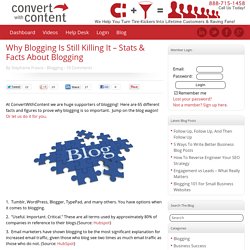
Here are 65 different facts and figures to prove why blogging is so important. Jump on the blog wagon! Or let us do it for you. 1. Tumblr, WordPress, Blogger, TypePad, and many others. 2. 3. Blogging Statistics, Facts and Figures in 2012 - Infographic. Blogging started as an online journal in the 1990′s where people shared their interests, hobbies and thoughts online.
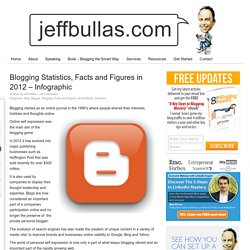
Online self expression was the main aim of the blogging game. In 2012 it has evolved into major publishing businesses such as Huffington Post that was sold recently for over $300 million. It is also used by companies to display their thought leadership and expertise. Blogs are now considered an important part of a companies participation online and no longer the preserve of the private personal blogger. The evolution of search engines has also made the creation of unique content in a variety of media vital, to improve brands and businesses online visibility to Google, Bing and Yahoo. Blogging Infographic. The Blogconomy Blogging Statistics. A history of blogging. There are very few websites online today that don't incorporate some form of blog.
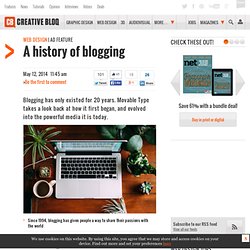
Whether it's an international news outlet, a local restaurant or your friend's online diary, it seems like everybody these days is blogging about something. But this hasn't always been the case. Blogging has only existed for about 20 years. However, a lot has happened in those 20 years. Somewhere along the line, blogs stopped only being a place for angsty teens to share their innermost thoughts and personal poetry. Here we take a look at how individuals' need for a simple mechanism to easily update website content evolved, and eventually turned the way we spread ideas completely on its head. The early days The early internet was raw.
In the early 1990s, web pioneers created sites with bulletin boards and discussion forums. In 1994, the world witnessed the birth of what many agree to be the very first blog. The era of online diaries And that changed everything. The paradigm shift. Top Blogging Statistics: 45 Reasons to Blog. Top Blogging Statistics: 45 Reasons to BlogWhether you are a small business owner just learning nuts and blots of blogging magic or already a blogging guru, you need to keep abreast of the most important blogging trends if you want to succeed in your blogging efforts.
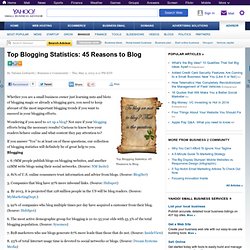
Wondering if you need to set up a blog? Not sure if your blogging efforts bring the necessary results? Curious to know how your readers behave online and what content they pay attention to? The Blogconomy: Blogging Stats [INFOGRAPHIC] Blogging Statistics, Facts and Figures In 2012 (Infographic) Blogging started as an online journal in the 1990′s where people shared their interests, hobbies and thoughts online.
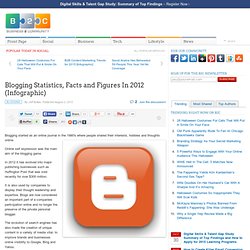
Online self expression was the main aim of the blogging game. In 2012 it has evolved into major publishing businesses such as Huffington Post that was sold recently for over $300 million. It is also used by companies to display their thought leadership and expertise. How to Make Money Blogging. If you’ve ever considered starting your own fashion blog, you’ve probably considered the following question: How can I make blogging my full-time job, and make money in the process?

Plus, how to start a fashion blog and do it correctly is a challenging task all on its own. It’s one thing to have a personal style blog—pretty much everybody and their mom (sometimes literally!) Has one, since most platforms are free to start and easy to use—but it’s quite another to take that platform and make it something that nets you actual income. “Honestly, it’s not easy to make money,” said Natalie Decleve of Natty Style. “And it’s not easy to maintain. Timeline: The Life of the Blog. Once a Stepping Stone to Print, Blogs Are Now a Destination Unto Themselves. In 2009, Italian fashion house Dolce & Gabbana made news by filling its front row—typically the sole provenance of A-list actresses and Anna Wintour—with fashion bloggers, even equipping them with laptops.
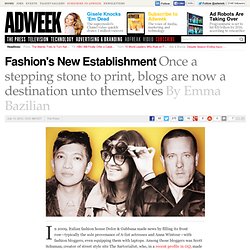
Among those bloggers was Scott Schuman, creator of street style site The Sartorialist, who, in a recent profile in GQ, made no effort to hide his indignation over that show. “[Dolce & Gabbana] got a humongous amount of press. … ‘Look, we brought the bloggers in and gave them the front row. Look at the dancing-monkey bloggers!’ ” He then added, “I could barely bring myself to sit down.” But since then, style blogs like The Man Repeller, Into the Gloss, Style Rookie and Bryanboy, aka Bryan Grey Yambao (look for him judging the next season of America’s Next Top Model), have become assigned reading among the fashion set—and you’d be hard-pressed to find them missing a single Fashion Week.
Just ask Nick Axelrod, a former news editor at Elle. The Most Important Moments In Fashion Blogging History. Do you know your fashion blogger history?
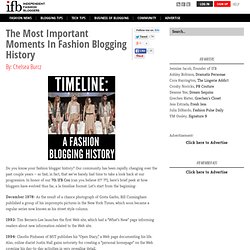
Our community has been rapidly changing over the past couple years — so fast, in fact, that we’ve barely had time to take a look back at our progression. In honor of our 7th IFB Con (can you believe it!? 7!!) , here’s brief peek at how bloggers have evolved thus far, a la timeline format. Let’s start from the beginning: December 1978: As the result of a chance photograph of Greta Garbo, Bill Cunningham published a group of his impromptu pictures in the New York Times, which soon became a regular series now known as his street style column. 1992: Tim Berners-Lee launches the first Web site, which had a “What’s New” page informing readers about new information related to the Web site. Fashion Blogging: the expressive side of fashion.
By Reeanna Lynn Hernandez In the year 2013, if you were a real fashionista, you wouldn’t be bragging about it–you’d be blogging. photo by Reeanna Lynn Hernadez A vogue-chic trend on the rise in this media driven era is the art of fashion blogging.

In the year 2013, blogs of all topics have become expressive online forums. Fashion blogs may cover a variety of different topics, focusing on clothing items, fashionable boutiques, celebrity styles, vintage wear, beauty trends, lifestyles of a fashionista, or if not just one of these, all of the above. The fashion industry is one that shapes the lives of people everywhere.
Fashion Blogging: The beginning of the trend. A Timeline of the History of Blogging. A brief history of blogging - Generation Blog. Blogs have become some of the most popular sites on the internet today. Most people today visit several blogs each day whether it is to get the latest news, to follow their favourite online personality’s daily endeavours or simply to stay entertained. Blogs as with other web based services had a very natural growth and evolution from humble roots up until the moment they experienced and almost exponential growth. The first blog like sites to appear on the internet were small moderated forums and news groups which were common place in the early days of the internet spanning the late eighties and early nineties.